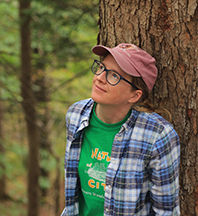Week of October 6, 2024 – October 12, 2024

by Anna Stunkel, Environmental Educator
Both spring and fall are exciting transitional times in the natural world around us. Here at Baltimore Woods, I always look forward to the arrival of fifth graders from the Syracuse City School District for their Ecosystem Exploration field trip. For many of these kids, it is their first time exploring such extensive forest, field, and water ecosystems. So far this year, I’ve led just two of these trips but have many more planned for the upcoming weeks.
As the students depart buses and walk through the crunchy leaves to greet us, they are abuzz with excitement. They often ask questions like, “are there lions or bears here? What kinds of animals will we see? Do you guys [the educators] live here?!” They are sometimes a little hesitant about venturing into the woods, but it’s great to watch them gradually become more comfortable in the new environment.
This field trip is all about the connections that happen within and between ecosystems– energy flow, food webs, human impacts, and interactions between living and non-living things. Students are often excited to share what they know about different roles within a food web. As they gently hold salamanders and poke puffballs to release the spores, they discover that nature isn’t just in books, videos, or zoos. It’s right around us every day, and the interactions between different beings are similar to how humans go about their days in cities and towns. Wild animals, plants, and other organisms play important roles in ecosystems and have similar needs as humans. Decomposers break down organic material in the leaf litter like garbage collectors clean up our trash. Plants use energy from the sun to provide food for countless animals, including humans. And other animals need to be safe and healthy just like we do.
This field trip helps students not only to learn about ecosystems and experience the joy of exploring outdoors, but also to discover the importance of connections and similarities between ourselves and the rest of nature. Through these similarities, children realize that they are a part of nature rather than separate from it. Although the modern world often finds us spending a lot of time indoors, no matter where you go there are always going to be other living things around you. We depend on nature for healthy food, clean water and air, and emotional well-being. We hope that thanks to the discoveries that these students make in their final year of elementary school, they have lasting memories that encourage them to be curious about nature throughout their lives.

